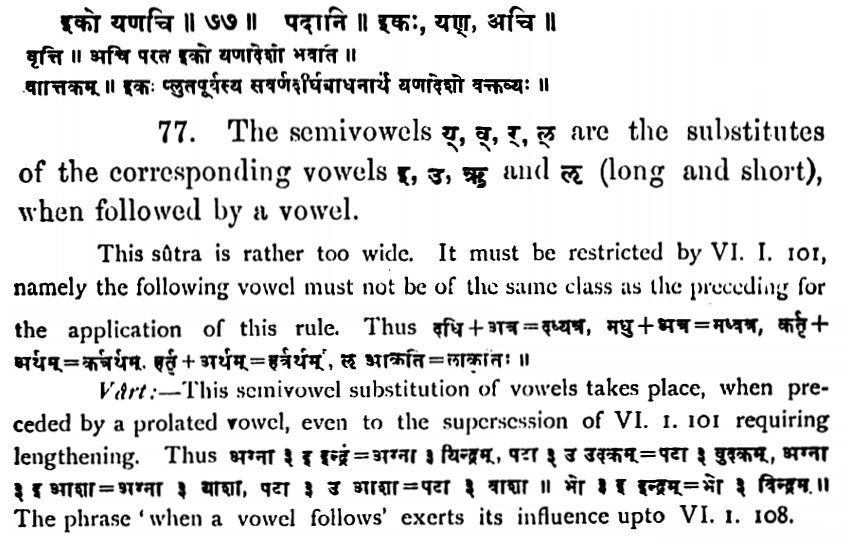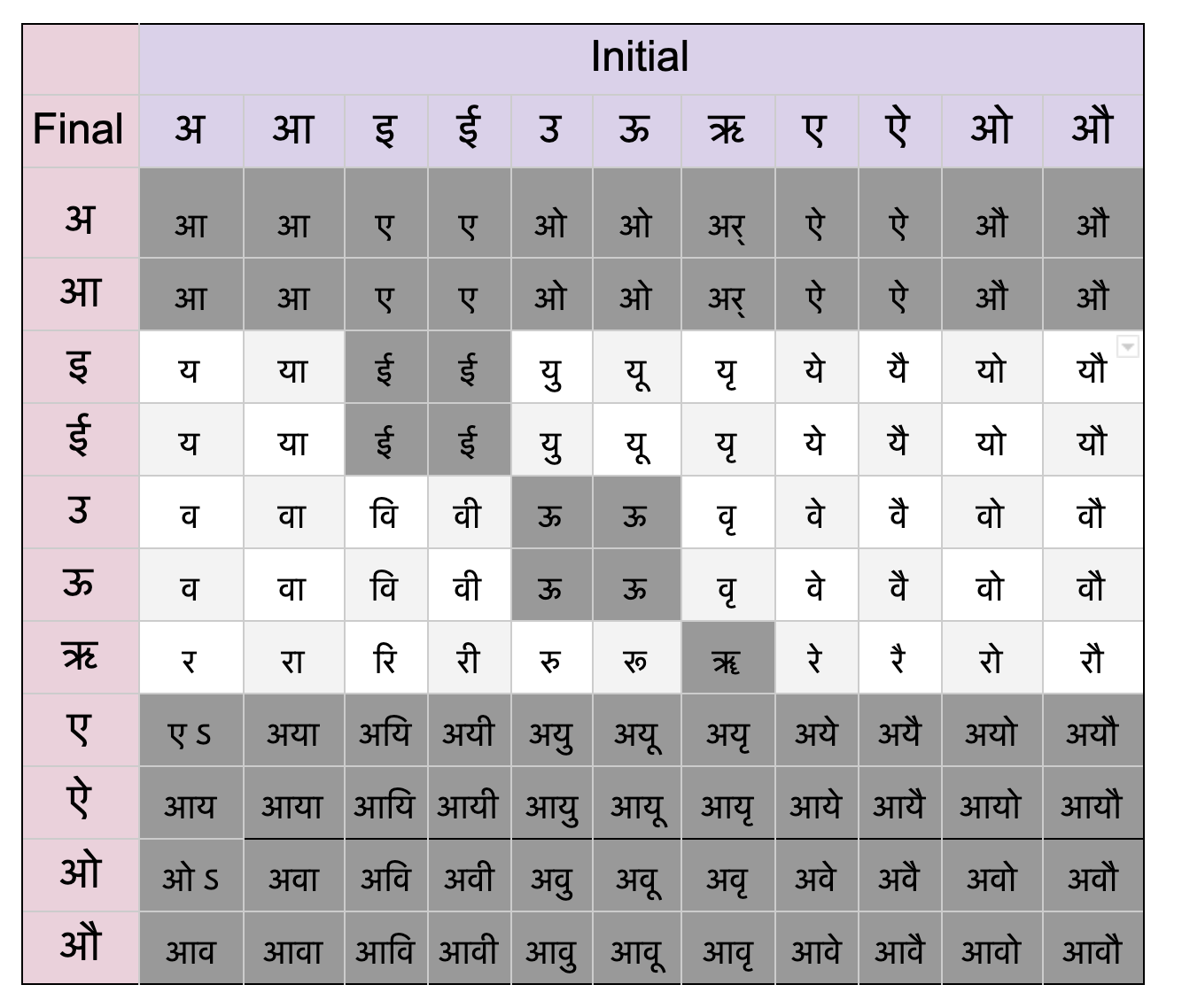The Secrets of Sanskrit Grammar with Māheśvara Sūtras
Learn the decryption key to Sanskrit Grammar...
In Hinduism, it is said that Lord Śiva created the whole universe by producing spiritual sounds on the ḍamaru, a cosmic drum. These sounds were the Sanskrit alphabet 😍
The order that these sounds came out in are heard in the 14 Māheśvara Sūtras that Dr. Bhaswati Bhattacharya taught me about:
१. अ इ उ ण्।
२. ऋ ऌ क्।
३. ए ओ ङ्।
४. ऐ औ च्।
५. ह य व र ट्।
६. ल ण्।
७. ञ म ङ ण न म्।
८. झ भ ञ्।
९. घ ढ ध ष्।
१०. ज ब ग ड द श्।
११. ख फ छ ठ थ च ट त व्।
१२. क प य्।
१३. श ष स र्।
१४. ह ल्।
These sutras require a bit of decoding, which Dr. Bhaswati shared with me.
Where are the Long Vowels?
First, if you try to match these letters to the Sanskrit alphabet, you will notice that some of the long vowels are missing, including आ ई ऊ ॠ ॡ. Since these are of the same “color” as their short counterparts अ इ उ ऋ ऌ, they are assumed by default and are therefore included.
ए vs ऐ and ओ vs औ are considered to be unique enough sounds, where they do have separate sutras to include both!
The Bookmarks
You will notice that each sutra ends with a letter + virama. For example, the first sutra ends with ण्, the second sutra ends with क्, the third sutra ends with ङ्, etc. These are to be considered not as letters themselves, but as bookmarks.
The Shortcut
So now we can have grammar shortcuts to include certain letters. For example, when I say अच् - we find अ in the first sutra and include all letters except the bookmarks until we reach च् as the bookmark in sutra 4.
१. अ इ उ ण्।
२. ऋ ऌ क्।
३. ए ओ ङ्।
४. ऐ औ च्।
Remember that the long vowels are assumed, and the bookmarks are just bookmarks and are therefore not included. So this will include letters अ आ इ ई उ ऊ ऋ ॠ ऌ ॡ ए ओ ऐ औ - all the vowels!
इको यणचि (iko yaṇaci)
So now let’s use this to decrypt an actual Sanskrit grammar rule from Pāṇini, an ancient Sanskrit philologist and grammarian.
Pāṇini calls this rule इको यणचि - you can see it in Book 6, Chapter 1, Sutra 77 (6.1.77):
If we undo the Sandhi (letter combinations) of this rule इको यणचि, the three words that emerge will be इकः यण् अचि.
इकः
इकः refers to all the letters in the Maheshawara Sutras from इ to क्:
१. अ इ उ ण्।
२. ऋ ऌ क्।
So this includes इ ई उ ऊ ऋ ॠ ऌ ॡ. Note that अ is NOT included as we’re starting from इ!
यण्
The second word यण् refers to all the letters in the Maheshawara Sutras from य to ण् :
५. ह य व र ट्।
६. ल ण्।
So this includes य व र ल.
अचि
I have already mentioned अच् refers to all the vowels:
१. अ इ उ ण्।
२. ऋ ऌ क्।
३. ए ओ ङ्।
४. ऐ औ च्।
अ आ इ ई उ ऊ ऋ ॠ ऌ ॡ ए ओ ऐ औ
Putting it Together
This means that when a word with the last letter as इ ई उ ऊ ऋ ॠ ऌ ॡ (इकः) combines with a word that starts with a vowel (अचि), the substitute sandhi letters य व र ल (यण्) should respectively be used as follows:
इ + vowel = य, ई + vowel = य
उ + vowel = व, ऊ + vowel = व
ऋ + vowel = र, ॠ + vowel = र
ऌ + vowel = ल, ॡ + vowel = ल
Here it is in the light squares on the Sandhi chart I created where a word that ends with a vowel (final) is combined with a word that begins with a vowel (initial):
Note that ॠ and ऌ are not included in this chart, as they are very very rarely used!
Examples:
कर्मसु (in fruitful activities) + अनुषज्जते (one necessarily engages) = कर्मस्वनुषज्जते (उ + अ = व), Bhagavad Gita, Chapter 6.4
इति (thus) + उच्यते (is said) = इत्युच्यते (इ + उ = यु), Bhagavad Gita, Ch 6.8
अनुगृह्णाति (maintains) + अविकृतः (normal state) = अनुगृह्णात्यविकृतः (इ + अ = य), Ashtangra Hrdaya, Sutrasthana, Ch 11.2
Conclusion
Just like reading the ancient Ayurvedic texts, the Sanskrit grammar rules themselves are highly encrypted and need a guide to help you learn them. The Māheśvara Sūtras are one such decryption key, so if you’re serious about learning Sanskrit, learn these sutras!
Thank you Dr. Bhaswati for being my guide 🙏



